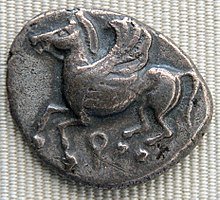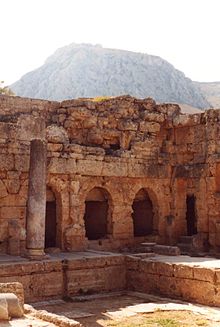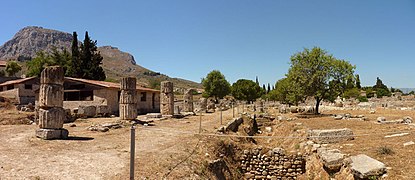Corinth (ancient city)
Corinth ( Greek Κόρινθος Korinthos ( f. Sg. ), Pronunciation : [ ˈkɔrintʰɔs ]) is an ancient Greek city near the Isthmus of Corinth , i.e. the isthmus , an isthmus that connects the Peloponnese and the Greek mainland. To the west of this isthmus is the Gulf of Corinth . The city is surrounded by the coastal plain of Vocha in the west, the Gerania Mountains in the east, and the Oneia Mountains in the south. Earthquakes have repeatedly destroyed the city.
Corinth is about 75 km west of Athens . The isthmus was crossed by ships in antiquity by being towed over the rocky isthmus on ship carts in prefabricated ruts. The route to this is known under the name Diolkos . However, the Corinth Canal has been located here since the end of the 19th century .
history
Some particularly old place names that end in -inthos like Korinthos or have the suffix -nt (h) come from a language before Greek . According to the myth, Sisyphus is the ancestor of a number of kings in Corinth. Jason is said to have left Medea here.
Corinth originally wrote itself Ϙόρινθος Qorinthos , with (the later abolished) Qoppa , which is why a ϙ is found on Corinthian coins as a mint mark.
Thanks to the traffic and trade over the isthmus, this ancient city, which dates back to around the 10th century BC It was repopulated by the Dorians during the period of classical Greek antiquity and rivaled Athens and Thebes for wealth. Until the middle of the 6th century BC Corinth was an important exporter of black-figure ceramics and supplied cities throughout the Greek world. The great temple on its acropolis ( acrocorinth ) was dedicated to Aphrodite . Corinth was one of the most important places of the Aphrodite cult. According to some sources, there were more than a thousand temple servants at the Temple of Aphrodite. Corinth also hosted the Isthmian Games .
Classical antiquity
Around 730 BC Some Corinthians emigrated to found new cities: Kerkyra (Corfu) and Syracuse in Sicily. There are many legends about the founder of the city of Syracuse, Archias. In 664 BC Corinth and Kerkyra met in the first Greek sea battle in history (Thuk. I 13). In the 7th century BC When Corinth was ruled by the tyrants Kypselus and Periander , the city sent further colonists to found cities, for example Poteidaia on the Chalkidiké peninsula, Ambrakia , Apollonia and Anaktorion and together with their colony Kerkyra the cities of Leukas and Epidamnos . The city was an important participant in the Persian Wars and provided the second largest fleet contingent after Athens during the Battle of Salamis . The city also took part in the battle of Plataiai (479 BC) with a large contingent . But it soon came to a rift with Athens after the Athenian Kimon in 462 BC. BC crossed the Corinthian area with his troops without permission. An open war broke out in which Corinth, in league with Epidauros, defeated the Athenians at Halieis , but later lost an important naval battle in the Saronic Gulf . Not until 451 BC There was an armistice with Athens, later a peace treaty.
The dispute continued to smolder and ultimately led to the outbreak of the Peloponnesian War as one of the most important factors , when the Corinthian fleet first suffered a defeat while intervening in the internal political turmoil of the Kerkyrian colony of Epidamnos and in 433 BC. BC nevertheless won a brilliant victory in the sea battle at the Sybota Islands on the coast of Epeiros . Kerkyra turned to Athens for help. Corinth took the side of Sparta . After the end of the Peloponnesian War, given the increasing hegemony of Sparta, the city's government decided to move closer to the Athenians. This resulted in 394 BC. At the outbreak of the Corinthian War , in which Corinth and Athens fought again together with Thebes and Argos against Sparta. 392 came through a coup in Corinth, the democrats to the government, which operated a state union with Argos (392-386). In 390 the battle of Corinth took place under the walls of the city , which came about through internal party struggles and in which citizens of the city fought on both sides. In 386 the Greeks bowed to the will of Sparta and the Persian king to accept a general land peace . Argos had to evacuate the city, and the aristocrats who had regained power turned towards Sparta.
337 BC Corinth fell under the rule of the Macedonians . After the murder of the Macedonian king Philip II of Macedon in 336 BC. The Federal Assembly in Corinth elected his son Alexander the Great as a common strategist (Greek: hegemon) for the Persian campaign planned by Philip. In the period that followed, the city was under the rule of Macedonian nobles. During this time Corinth became the most populous city in Greece and was known far beyond local areas for its thriving economic and cultural life. 243 BC The city was attacked and taken by the strategist of the Achaean League named Aratos. Under the rule of this eminent statesman, she joined this league. When the inhabitants of the city, dissatisfied with his government, turned to the Spartan king Cleomenes III. turned with the request for help, Aratos passed the rule of Corinth to the Macedonian king Antigonus III. Doson in 224 BC From. The victory of the Romans at the Battle of Kynoskephalai in 197 BC BC brought the Corinthians the liberation from the Macedonian patronage, because the Romans forced the Macedonian garrison to withdraw. After the Macedonians were expelled, Corinth belonged to the Achaean League and now pursued a decidedly anti-Roman policy.
After 146 BC When the Achaean League declared war on Sparta, there were military clashes with the Roman armies. The victorious Romans under the command of the general Lucius Mummius besieged Corinth, which became the center of anti-Roman resistance, destroyed it in the same year, murdered and enslaved the surviving inhabitants. The area fell partly to Sikyon , the majority was declared a Roman ager publicus .
Roman times and late antiquity
Even if there is some archaeological evidence of minimal settlement after the destruction of Corinth in 146 BC. BC, it didn't come until 44 BC. To a re-establishment of the city by Gaius Iulius Caesar as a Roman citizen colony under the name Colonia Laus Iulia Corinthiensis . According to the Roman historian Appian , the settlers were freedmen from Rome. Under the Romans it became the administrative seat of the province of Achaea in southern Greece, and for several decades the city was a Latin-speaking island in the middle of a Greek environment.
As early as the 2nd century AD, Corinth became the seat of a bishopric, at the latest in the 4th century the seat of a metropolitan, and it remained in this position until the rise of Athens at the beginning of the 9th century. In 267 the city was badly destroyed during the invasion of the Goths and Heruli , but was quickly rebuilt. For more than a hundred years it flourished until Alaric I had it plundered in 395 during the Visigoth invasion of Greece (395–396) and sold many of its citizens into slavery. Nevertheless, Corinth was able to recover again. In 521 the city was badly damaged as a result of a severe earthquake; Emperor Justin I had it rebuilt. The beginning of the Slav invasions (around 580) brought ancient life in the city to an almost complete standstill. Only decades later did a modest economic recovery take place.
Middle Ages and Modern Times
In 1147 the Gulf of Corinth became the base of operations of the Norman Roger II against the region of Arta. Roger soon occupied Corinth himself and, using force, relocated all native silk weavers to Palermo . Soon the city was re- incorporated by Byzantium . In 1202 a high Byzantine official, Leon Sguros, managed to make himself master of the city, but in 1204 his rule was ended by the participants in the Fourth Crusade , who took the city. In 1210 Corinth became part of the newly created Principality of Achaia and thus part of the Latin Empire . In the period that followed, the city saw several alternating rulers who made it the scene of bloody battles for influence on southern Greece. From 1421 to 1458 it was in the Byzantine possession. In 1458 the Ottomans took power in Corinth, which had already become completely insignificant. In 1611 the Knights of the Order of Malta launched an attack on Corinth, which seriously affected the city. From 1687 to 1715 the Venetians ruled over the place, in which only 1,500 inhabitants lived. At the end of the Ottoman rule in 1821, the city had 15,000 inhabitants and rapidly decreased to a few hundred during the Greek Revolution . At the beginning of the Greek struggle for independence, consideration was given to making Corinth the capital of the free Hellenic state. On February 21, 1858, old Corinth, which then had about 4,000 inhabitants, was destroyed by an earthquake and then rebuilt six kilometers to the northeast. The village of Archea Korinthos is located directly next to the ancient settlement area . In the past twenty years Corinth has become an important tourist center in the Peloponnese.
Excavations
Only the temple of Apollo from the middle of the 6th century BC, which was located above the agora , gives evidence of the size and importance of the archaic city . Seven larger pillars still stand from it. The ruins give a very good impression of an important Roman city. The large agora is remarkable, the huge area of which probably received its recognizable form as early as the 4th century BC. To the east of the agora are the remains of the Basilica Iulia, a courthouse built by Emperor Claudius in 44 AD . In the center of the agora you can see the base of the speaker's platform (bema), where the apostle Paul had to answer to the Roman proconsul . In the Middle Ages this place was built over by a church. In the north of the agora, the Propylaea , a gateway from the 1st century AD, formed the beginning of the magnificent Lechaion Street, which had remained almost unchanged until the 10th century AD. Along this street there were shops and a basilica that stood where the old town market had once been. It can be assumed that Lechaion Street formed a kind of "shopping mile" in the late ancient city of Corinth, where almost all of public life took place. A well-preserved latrine can also be seen there. This area was in the 11./12. Century built over again by houses of rich Byzantines. In the 17th century, the palace of the Ottoman Bey , the governor of the city, was built north of it , of which hardly anything remains.
In the south the agora is bounded by the 154 m long stoa that Philip II of Macedonia had built after 338 BC. BC as a guest house for the members of the Corinthian League. There were numerous shops at the back. During the time of Roman rule, the southern part of the Stoa was made the "administrative seat" of the Isthmian Games .
The well house of the source of the Peirene , which was famous for its clear water , is richly furnished . The water was accessible under six arcades (built by Augustus ), many statues adorned the building, in front of which there was also a swimming pool. Also worth mentioning is a large theater (from the 4th century BC, with many later modifications), which was replaced in Roman times by a building equipped with an arena , where it is said that the staging of naval battles, the naumachia , was possible be.
The Odeion in the immediate vicinity dates from the 1st century AD and was modified by Herodes Atticus in the 2nd century . In the south of the archaeological area of Corinth are the remains of an episcopal church from the 5th century AD, which were covered by a new building from the 11th century. The last redesign took place in the 13th century. From the wall ring, destroyed by the Roman general Mummius in 146 BC. In several places up to 40 m long sections can still be seen.
museum
There is a small museum on the excavation site. In the rooms, which are grouped around an inner courtyard, you can see antique vases, mosaic pictures, wall paintings and sculptural works from Greek and Roman times.
Detail of the shed armor of a Roman tank statue
Corinth in the Bible
The Corinth of the Bible was a multicultural and multireligious city, shaped by different ethnic groups. When the Apostle Paul first visited the city in 51 or 52, Gallio , a brother of the philosopher Seneca , was proconsul . Paul stayed there for 18 months ( Acts 18 : 1–18). Here he met Aquila and Priscilla for the first time . Shortly after his departure, Apollos also came to Corinth from Ephesus . From Ephesus, Paul then wrote his first letter to the Corinthian congregation around the year 55 AD - that is, twenty years after the origin of the original Church in Jerusalem .
The letter to the Romans was probably written during the third stay of the apostle Paul in the spring of 58 . The second letter to the Corinthians reflects the difficulties a Christian community to maintain in such a cosmopolitan city.
Corinth in literature
Goethe wrote a morbid ballad called The Bride of Corinth , which was set in antiquity . Even Schiller did the same: The Cranes of Ibykus play in ancient Corinth. Corinth also plays a major role in Wolf's Medea , as according to the ancient legend. After the successful search for the golden fleece, the city is the target of Medea and Jason on their escape from Iolkos .
Miscellaneous
Because of the high prices for foreigners, for which Corinth was known in antiquity, the saying "Not every thing is worth a trip to Corinth" arose.
Personalities
Born here
- Periander († 583 BC), tyrant ruler around 628 BC BC, made the city famous and later was one of the seven wise men.
See also
literature
- JB Salmon: Wealthy Corinth: Ahistory of the city to 338 BC . Special ed Clarendon, Oxford 1997, ISBN 0-19-814833-X .
- Petros G. Themelis: Ancient Corinth. The site and the museum, briefly illustrated archeological guide. Editions Hannibal, Athens 1998.
- Hanns-Peter Mederer: "Let the booming harp wake us up". The venues of the competitions and victory celebrations in Pindars Epinikien. In: Antike Welt 8. 2003, pp. 433–440.
- Franz N. Mehling, Evangelos Konstaninou: Knaur's cultural guide in color Greece . Licensed edition, Weltbild-Verlag, Augsburg 1998, ISBN 3-8289-0670-2 .
- Stuart Rossiter: Guide to Greece . 4th edition, ira, Munich 1984, ISBN 3-406-09251-9 .
- Hans-Joachim Gehrke : Stasis: Investigations into the internal wars in the Greek states of the 5th and 4th centuries BC Chr (= Vestigia. Volume 35). CH Beck, Munich 1985, ISBN 3-406-08065-0 .
- RF Willetts (Ed.): Book series: States and Cities of Ancient Greece . London 1972.
- Rudolf Scheer: Corinth. In: Siegfried Lauffer (Ed.): Greece: Lexicon of historical sites - from the beginnings to the present . CH Beck, Munich 1989, ISBN 3-406-33302-8 , pp. 338-343.
Web links
Individual evidence
- ^ John L. Caskey: Greece and the Aegean Islands in the Middle Bronze Age. In: The Cambridge Ancient History . Volume 2, Part 1. Third edition. Cambridge University Press, Cambridge 1973, pp. 135-140, here p. 139; Benjamin W. Fortson: Indo-European Language and Culture. An Introduction. Blackwell, Oxford 2004, p. 248.
- ↑ Inscriptiones Graecae I 3 1143 (480/79 BC).
- ^ Hermann Wagener (Ed.): State and Society Lexicon: New Conversations Lexicon , Volume 11, Berlin 1862, pp. 501–503 ( online )
- ↑ He doesn't lull you into psycho-technical exercises. Kath.net , April 9, 2007
- ^ A more detailed description of the travels of the apostle Paul (according to the Bible) under Wielding the Sword of the Spirit (English)
Coordinates: 37 ° 54 '21.7 " N , 22 ° 52' 45.3" E












